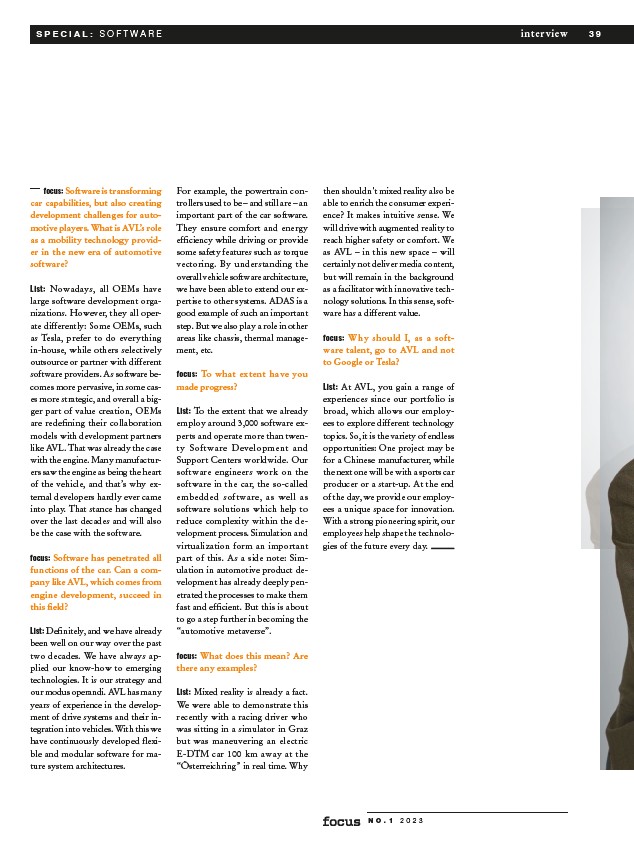
S P E C I A L : S O F T WA R E interview 3 9
N O . 1 2 0 2 3
focus: Software is transforming
car capabilities, but also creating
development challenges for automotive
players. What is AVL’s role
as a mobility technology provider
in the new era of automotive
software?
List: Nowadays, all OEMs have
large software development organizations.
However, they all operate
differently: Some OEMs, such
as Tesla, prefer to do everything
in-house, while others selectively
outsource or partner with different
software providers. As software becomes
more pervasive, in some cases
more strategic, and overall a bigger
part of value creation, OEMs
are redefining their collaboration
models with development partners
like AVL. That was already the case
with the engine. Many manufacturers
saw the engine as being the heart
of the vehicle, and that’s why external
developers hardly ever came
into play. That stance has changed
over the last decades and will also
be the case with the software.
focus: Software has penetrated all
functions of the car. Can a company
like AVL, which comes from
engine development, succeed in
this field?
List: Definitely, and we have already
been well on our way over the past
two decades. We have always applied
our know-how to emerging
technologies. It is our strategy and
our modus operandi. AVL has many
years of experience in the development
of drive systems and their integration
into vehicles. With this we
have continuously developed flexible
and modular software for mature
system architectures.
For example, the powertrain controllers
used to be – and still are – an
important part of the car software.
They ensure comfort and energy
efficiency while driving or provide
some safety features such as torque
vectoring. By understanding the
overall vehicle software architecture,
we have been able to extend our expertise
to other systems. ADAS is a
good example of such an important
step. But we also play a role in other
areas like chassis, thermal management,
etc.
focus: To what extent have you
made progress?
List: To the extent that we already
employ around 3,000 software experts
and operate more than twenty
Software Development and
Support Centers worldwide. Our
software engineers work on the
software in the car, the so-called
embedded software, as well as
software solutions which help to
reduce complexity within the development
process. Simulation and
virtualization form an important
part of this. As a side note: Simulation
in automotive product development
has already deeply penetrated
the processes to make them
fast and efficient. But this is about
to go a step further in becoming the
“automotive metaverse”.
focus: What does this mean? Are
there any examples?
List: Mixed reality is already a fact.
We were able to demonstrate this
recently with a racing driver who
was sitting in a simulator in Graz
but was maneuvering an electric
E
DTM car 100 km away at the
“Österreichring” in real time. Why
then shouldn't mixed reality also be
able to enrich the consumer experience?
It makes intuitive sense. We
will drive with augmented reality to
reach higher safety or comfort. We
as AVL – in this new space – will
certainly not deliver media content,
but will remain in the background
as a facilitator with innovative technology
solutions. In this sense, software
has a different value.
focus: Why should I, as a software
talent, go to AVL and not
to Google or Tesla?
List: At AVL, you gain a range of
experiences since our portfolio is
broad, which allows our employees
to explore different technology
topics. So, it is the variety of endless
opportunities: One project may be
for a Chinese manufacturer, while
the next one will be with a sports car
producer or a start-up. At the end
of the day, we provide our employees
a unique space for innovation.
With a strong pioneering spirit, our
employees help shape the technologies
of the future every day.